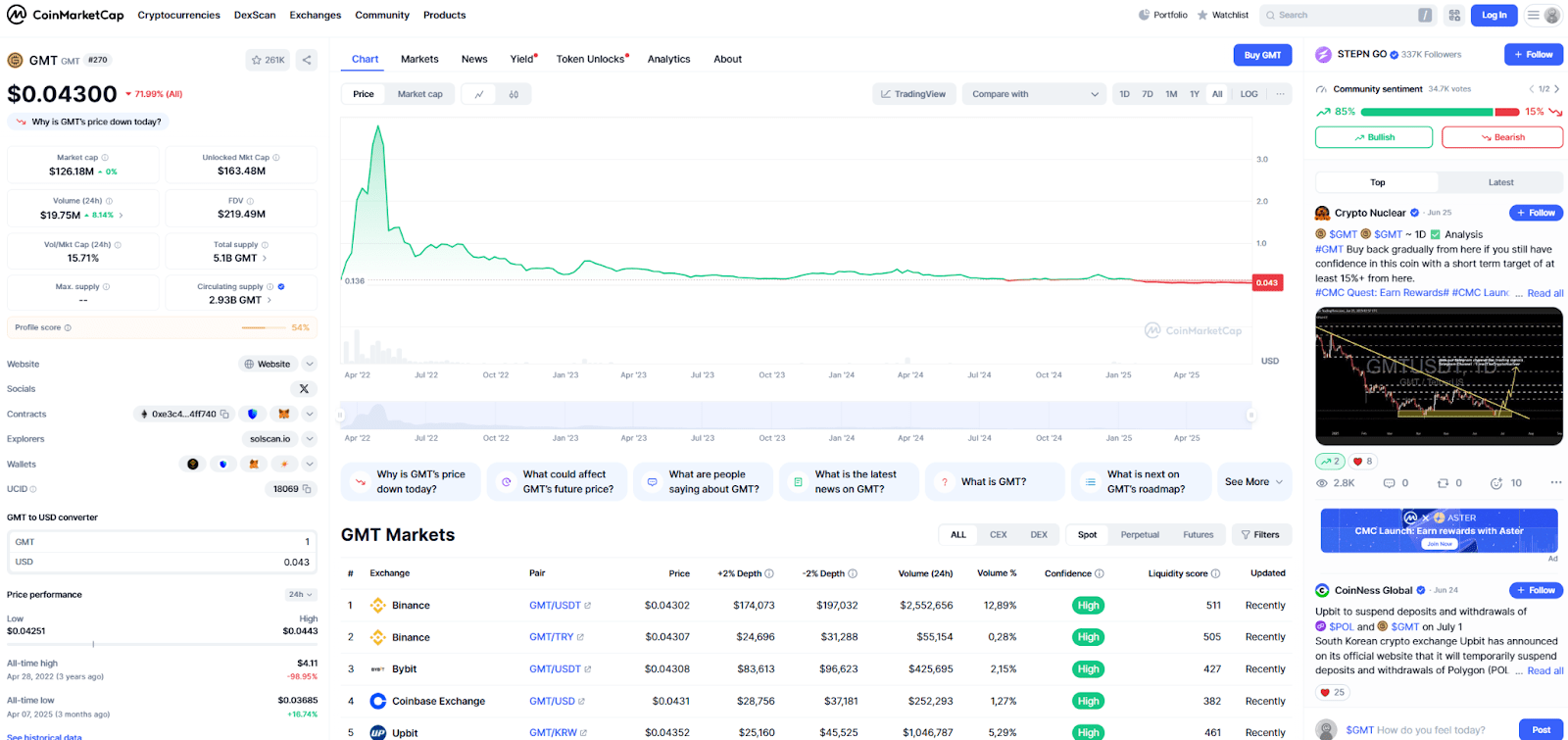

GMT (GMT) Review
GMT (GMT) is a token that is generating buzz among the blockchain and cryptocurrency sector. Whether you are an experienced investor or it is new territory for you, knowing about GMT and its place in the cryptocurrency realm is central to making good investment decisions. In this review of GMT, we will explore in depth the token itself, its technology, its application, and where it fits into the larger crypto world.
What is GMT (GMT)?
GMT (GMT) is the original coin of the Stepan ecosystem, which is focused on merging blockchain technology and fitness. The project incentivizes individuals to be active by rewarding them for training sessions, and it presents an uncommon overlap of both the fitness and decentralized finance (DeFi) industries.
The user can monitor their physical activities such as walking, running, and other workouts through the Stepan application and get rewarded GMT tokens. This blending of blockchain and health has gained traction and positioned GMT among the most creative projects on the cryptocurrency map.
The Ecosystem Underlying GMT
Stepan is the central platform for the GMT token. It's an app that operates on a move-to-earn model, where people can be rewarded for completing workout tasks. The more active people are, the higher rewards they can receive in GMT tokens, which can either be spent on things from the Stepan ecosystem or be sold on cryptocurrency exchanges.

Stepan uses blockchain technology to be transparent and decentralized. With decentralized finance (DeFi), it offers an alternative and new way for people to live healthy while simultaneously participating in the growing trend of digital currencies.
Technologies Applied for GMT (GMT)
GMT is constructed on top of the Solana blockchain, itself well-known for its rapid transaction speeds and minimal costs. By using Solana, the Stepan platform can support many transactions at light speeds, and hence presents an effortless and smooth experience for holders who want to collect GMT tokens.
Moreover, integration of blockchain technology will also allow an irrefutable and open-ended record for every user action. In such a manner, all of the user's real-world activities such as steps taken or distance traveled are adequately documented and rewarded.
How GMT (GMT) Works: The Move-to-Earn Mechanism
The move-to-earn paradigm, on which Stepan is constructed, is a concept that integrates exercise and virtual money rewards. That's how it works:
- User Interactivity: Students download the Stepan app, which syncs with their fitness trackers or phones and captures their exercised activities.
- Earn GMT Tokens: For each physical activity done, the user will earn GMT tokens. It pays tokens based on how intensely and for how long someone exercised.
- Using GMT Tokens: Earned GMT tokens can be used to pay for purchases made from the application, staked to earn passive income, exchanged for other cryptocurrencies or fiat currencies.
- NFT Integration: To fortify the ecosystem, Stepan also integrates non-fungible tokens (NFTs) such that its members can buy or sell virtual products associated with fitness or even with the Stepan platform.
It urges people to adopt healthier lifestyles and, at the same time, benefit from blockchain and cryptocurrencies.
Applications for Real-World Use of GMT (GMT)
The application of GMT transcends fitness rewards. Some of its practical uses are discussed below:
- Staking: GMT tokens can be staked by users on the Stepan platform to be rewarded extra tokens over time.
- Governance: Because it's a decentralized protocol, Stepan allows GMT holders to participate in governance decisions and therefore it's a community-based platform.
- E-Commerce: These GMT tokens can be used on the platform to purchase any type of fitness-related items, services, and NFTs.
- Charity: Some of the participants would also contribute their GMT tokens towards health-related charitable works, hence expanding the token's social impact.
The Contribution of GMT to Society
GMT built a strong and growing community around the Stepan ecosystem. The fitness, health, and blockchain focus of its initiative have appealed to fans of fitness and cryptocurrency investors alike.
Stepan's community is actively contributing towards propagating the advantages of leading an active life and also participating in the crypto economy. The resolution of rewarding healthy habits with real-world financial rewards on the project's behalf has brought about loyal user retention.
Key Persons and Projects Who Participated in GMT
Although the Stepan team is quite faceless, there is some credibility gained from the alignment of its project beyond blockchain and leaders of the fitness sector. There are individuals from fields of blockchain, fitness, and technology on its team, who pool together varied expertise to advance its project.
Moreover, its integration into the broader Solana ecosystem and its usage among fitness apps have further resulted in its growing presence. Collaborations with fitness influencers and joint ventures with healthcare-related companies have also increased its reach.
The Future of GMT: What Comes Next?
The future for GMT is strong and the project continues to develop its ecosystem. There will be new features such as more fitness challenges, more staking features, and more ways to use the platform.
The incorporation of NFTs into its platform offers significant prospects for its members, including owning unique fitness-related virtual collectibles. Furthermore, Stepan's long-term goal is to be at the vanguard of the move-to-earn market, appealing to an astonishing number of individuals eager to earn cryptocurrency rewards while staying active.
Conclusion
GMT (GMT) isn't just another token but also a new age of digital currencies which are associated with real-world actions and which are at the crossroads between health and blockchain technology. Unlike any other token, GMT is a native coin of the world of Stepan where anyone can be rewarded for living active lifestyles all while participating in the universe of decentralized finance.
As the notion of move-to-earn continues to gain popularity, GMT can be a significant actor at the intersection between health and cryptocurrencies. Whether you are seeking rewards for remaining active or seeking to benefit from blockchain technology's potential, GMT offers an exciting and rewarding experience.
FAQ
What is GMT (GMT)?
GMT is the original token of Stepan, and it's applied on a move-to-earn platform where you get rewards for walking around on foot.
How can you earn GMT tokens?
GMT tokens can be earned by tracking your physical activities on the Stepan application. The more active you are, the more tokens you will earn.
What can you do with GMT tokens?
GMT tokens can be staked, used on in-app purchases, exchanged for other cryptocurrencies, sent towards fitness-related initiatives, and more.
Is Stepan exclusively for fitness enthusiasts?
While the actual site is health-focused, it complements health with financial rewards to entice a variety of people who are enthusiastic about health and cryptocurrencies.
Is GMT investment worth it?
As with all cryptocurrencies, volatility can be associated with GMT. Proactive study and consideration of risks are needed before making an investment.
May I use GMT to make purchases?
Indeed, you can utilize GMT in the Stepan ecosystem for buying virtual fitness products, services, or even NFTs for the project.
What's special about GMT in the world of cryptocurrencies?
GMT's move-to-earn framework is an innovative integration of fitness and blockchain, rewarding its users for living a healthier life and participating in DeFi.

Il n'y a pas encore d'avis. Soyez le premier.



